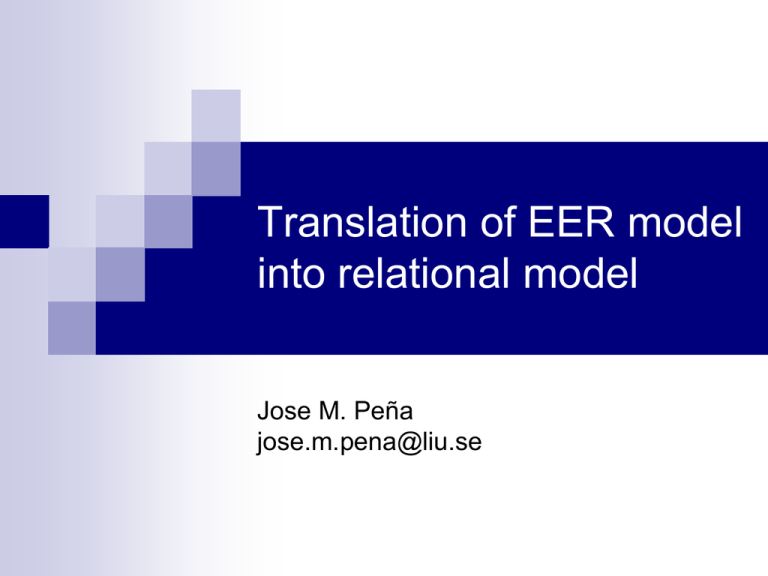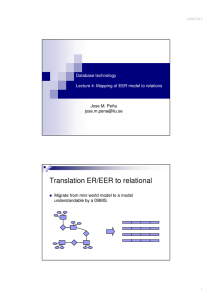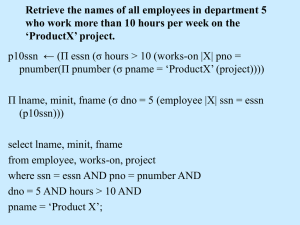
Translation of EER model
into relational model
Jose M. Peña
jose.m.pena@liu.se
Overview
Real world
Model
Databases
DBMS
Queries
Answers
Processing of queries and
updates
Access to stored data
Physical
database
Translation ER/EER to Relational
Migrate from mini world model to a model
understandable to a DBMS
EER model for the COMPANY
database
ER to Relations
Step 1: Mapping Regular Entity Types
For each strong entity type R, create a
relation E that has the same simple
attributes as R.
• Derived attributes are not stored.
• Composite attributes are not stored, their component ones are stored.
• Multivalued attributes are treated later.
PROJECT( Number, Name, Location)
EMPLOYEE(Ssn, Bdate, Fname, Minit, Lname, …)
Composite attributes are not stored, their component ones are stored.
DEPARTMENT ( Number, Name)
”Number_of_employee”: derived attribute are not stored.
”Location”: multivalued attributes are treated later.
S
ER to Relations
M
N
PKS
T
PKT
Ratt
Step 5: Mapping M:N Relationship Types
For each binary M:N relationship, identify
the relations S and T that correspond to
the connected entity types. Create a new
relation R and use the primary keys from S
and T as foreign keys and primary keys in
R. If there are attributes on the relation
these are also added to R.
On delete/update CASCADE ?!
S
PKS
R
PKS
T
PKT
PKT
Ratt
DEPARTMENT( Number, Name)
EMPLOYEE(Ssn, Bdate, Fname, Minit, Lname, …)
PROJECT( Number, Name, Location)
WorksOn( Ssn, Number, Hours)
S
ER to Relations
N
1
PKS
T
PKT
Ratt
Step 4: Mapping 1:N Relationship Types
1.
For each binary 1:N relationship, identify the relation S
that represents the entity type on the N-side of the
relationship type, and relation T that represents the
entity type on the 1-side of the relationship type. Include
as a foreign key in S the primary key of T. If there are
attributes on the relation these are also added to S.
On delete/update CASCADE ?!
T
S
PKS
PKT
PKT
Ratt
DEPARTMENT( Number, Name, Location)
EMPLOYEE(Ssn, Bdate, Fname, Minit, Lname, SupervisorSSN,...)
…)
PROJECT ( Number, Name)
WorksOn( Ssn, Number, Hours)
S
ER to Relations
N
1
PKS
T
PKT
Ratt
Step 4: Mapping 1:N Relationship Types
1.
2.
For each binary 1:N relationship, identify the relation S
that represents the entity type on the N-side of the
relationship type, and relation T that represents the
entity type on the 1-side of the relationship type. Include
as a foreign key in S the primary key of T. If there are
attributes on the relation these are also added to S.
Implement as M:N relationship (unlike M:N relationship,
now PK is PK(S)). Convenient if few tuples are
S PKS
T PKT
participate in the relationship.
On delete/update CASCADE ?!
R
PKS
PKT
Ratt
DEPARTMENT( Number, Name, Location)
EMPLOYEE(Ssn, Bdate, Fname, Minit, Lname, SupervisorSSN,...)
…)
PROJECT ( Number, Name)
WorksOn( Ssn, Number, Hours)
Supervision( Ssn, SupervisorSSN)
ER to Relations
Step 3: Mapping 1:1 Relationship Types
1.
Implement as 1:N relationship (prefer the entity type with
total participation, if any, as the entity type to which the
foreign key is added). Convenient if few tuples
participate in the relationship.
PROJECT( Number, Name, Location)
EMPLOYEE(Ssn, Bdate, Fname, Minit, Lname, …)
DEPARTMENT ( Number, Name, Manager)
S
ER to Relations
1
1
PKS
T
PKT
Ratt
Step 3: Mapping 1:1 Relationship Types
1.
Implement as 1:N relationship (prefer the entity type with
total participation, if any, as the entity type to which the
foreign key is added). Convenient if few tuples participate
in the relationship.
2.
For each binary 1:1 relationship B, identify the relations S
and T that correspond to the incoming entity types.
Merge S and T into a single relation R. Set the primary
key of S or T as the primary key of R. Do not forget the
attributes of the relationship type. Indicated only when S
and/or T with total participation.
S
PKS
PKT
Ratt
ER to Relations
Step 2: Mapping Weak Entity Types
For each weak entity type W with owner
entity type E, create a relation R that has
the same simple attributes as W, also add
(as a foreign key) the primary key
attributes from the relation that
corresponds to E.
Primary key attributes in R are composed of the primary key
attributes from E and the partial key from W.
On delete/update CASCADE ?!
DEPARTMENT( Number, Name)
EMPLOYEE(Ssn, Bdate, Fname, Minit, Lname, SupervisorSSN,...)
…)
PROJECT ( Number, Name)
WorksOn( Ssn, Number, Hours)
DEPENDENT( Ssn, Name, Sex, Birth_date, …)
ER to Relations
Step 2: Mapping Weak Entity Types
For each weak entity type W with owner
entity type E, create a relation R that has
the same simple attributes as W, also add
(as a foreign key) the primary key
What if
attributes from the relation that
the
owner
entity is
corresponds to E.
Primary key attributes in R are composed of the primary key
attributes from E and the partial key from W.
On delete/update CASCADE ?!
also
weak ?
ER to Relations
Step 7: Mapping N-ary Relationship Types
For each N-ary relationship with N>2, create a
new relation S that contains the primary keys
from the incoming relations as foreign keys.
Primary key of S are those keys that come from
cardinality constraints ≠ 1. Do not forget the
attributes of the relationship type.
On delete/update CASCADE ?!
N-ary relationships
Example. A person works as an engineer at one
company and as a gym instructor at another
company.
Employee
N
M
works as
JobType
Employee(PN, …)
K
JobType(JID, …)
Company
Company(CID, …)
Works_as(PN,JID, CID)
ER to Relations
Step 6: Mapping multivalued attributes
For each multivalued attribute A in R, create a new
relation P that contains one attribute for each attribute in
A and the primary key K of R as a foreign key. The
primary key of P is the combination of K and some
suitable simple attributes of A.
PostNum
PN
Name
Address
Street
On delete/update CASCADE ?!
Person(PN, Name)
Address(PN, PostNum, Street)
Person
ER to Relations
Materializing the relationship:
M:N implies two joins
1:N implies one or two joins
1:1 implies zero, one or two joins
N-ary implies N joins.
DEPARTMENT( Number, Name)
EMPLOYEE(Ssn, Bdate, Fname, Minit, Lname, …)
PROJECT( Number, Name, Location)
WorksOn( Ssn, Number, Hours)
SELECT E.Fname, P.Name, W.Hours
FROM EMPLOYEE E, PROJECT P, WorksOn W
WHERE W.SSN = E.SSN AND W.Number = P.Number
ER to Relations
Materializing the relationship:
M:N implies two joins
1:N implies one or two joins
1:1 implies zero, one or two joins
N-ary implies N joins.
PROJECT( Number, Name, Location)
EMPLOYEE(Ssn, Bdate, Fname, Minit, Lname, …)
DEPARTMENT ( Number, Name, Manager)
SELECT E.Fname, D.Name
FROM EMPLOYEE E, DEPARTMENT D
WHERE D.Manager = E.Ssn;
EER to Relations
Step 8: Mapping Specialization
a)
create relations for each class (super+sub)
ID
A
X(ID, A)
X
Y(ID, B)
Y
B
Z
Z(ID, C)
C
* Always works.
EER to Relations
Step 8: Mapping Specialization
b)
subclass relations only
ID
A
X
Y(ID, A, B)
Y
B
Z
Z(ID, A, C)
C
* Works only for total participation.
* Overlapping implies duplication.
EER to Relations
Step 8: Mapping Specialization
c)
single relation with one type attribute and all
subclass attributes
ID
No needed if
specialization is
attribute-defined.
A
X
X(ID, A, Type, B, C)
d
Y
B
Z
C
* Works only for disjoint subclasses.
* May produce many NULLs if many
subclass-specific attributes exist.
EER to Relations
Step 8: Mapping Specialization
d)
single relation with multiple type attributes
and all subclass attributes
ID
A
X
X(ID, A, IsY, B, IsZ, C)
Y
B
Z
C
* Always works.
* May produce many NULLs if many
subclass-specific attributes exist.
EER to Relations
Materializing the superclass/subclasses
Option a, inner/outer join.
Option b, outer join (against theory…).
Option c, done.
May be more space inefficient but
Option d, done. more time efficient.
EER to Relations
a)
create relations for each class (super+sub)
ID
A
X(ID, A)
X
Y(ID, B)
Y
B
Z
Z(ID, C)
C
SELECT X.ID, X.A, Y.B
FROM X LEFT JOIN Y ON X.ID = Y.ID;
EER to Relations
b)
subclass relations only
ID
A
X
Y(ID, A, B)
Y
B
Z
Z(ID, A, C)
C
SELECT Y.ID, Z.ID, Y.A, Z.A,Y.B, Z.C
FROM Y FULL OUTER JOIN Z ON Y.ID = Z.ID;
EER to Relations
Step 9: Mapping of Union Types
a)
If the defining superclasses have different
primary keys, introduce a surrogate key in
the union relation and use it as a foreign key
in the superclasses.
CompanyID
C
B
Y
Z
PersonID
Y(CompanyID, B, XID)
u
U
X
A
Z(PersonID, C, XID)
X(XID, A)
EER to Relations
Step 9: Mapping of Union Types
If the defining superclasses use the same
primary key, no need for surrogate key.
b)
PersonID
C
B
Y
Z
PersonID
Y(PersonID, B)
u
Z(PersonID, C)
U
X
X(PersonID, A)
A
* No FKs in Y and Z, unless total participation
(correct figure 7.7 in the book)
Example: LARM days
Town
Street
PostNum
PID
OrgNr
PhoneNum
Address
Name
Person
1
is-contact-for
1
Organization
o
Teacher
Student
N
shows
1
u
UID
U
Responsible
N
organizes
M
Exhibition
Description












